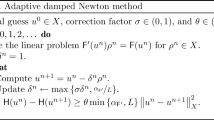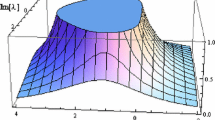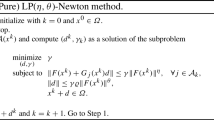Abstract
The piecewise linear system is a nonsmooth but semismooth equation. In this paper, a damped semismooth Newton method is presented for solving a class of piecewise linear systems. Under appropriate conditions, both monotone convergence and finite termination properties are investigated for the proposed method.

Similar content being viewed by others
References
Bear, J., Verruijt, A.: Modeling Groundwater Flow and Pollution. D. Reidel Publ. Co., Dordrecht (1987)
Brugnano, L., Casulli, V.: Iterative solution of piecewise linear systems. SIAM J. Sci. Comput. 30, 463–472 (2008)
Brugnano, L., Casulli, V.: Iterative solution of piecewise linear systems and applications to flows in porous media. SIAM J. Sci. Comput. 31, 1858–1873 (2009)
Brugnano, L., Sestini, A.: Iterative solution of piecewise linear systems for the numerical solution of obstacle problems. J. Numer. Anal. Ind. Appl. Math. 6(3–4), 67–82 (2011)
Casulli, V.: Semi-implicit finite difference methods for the two-dimensional shallow water equations. J. Comput. Phys. 86, 56–74 (1990)
Casulli, V.: A high resolution wetting and drying algorithm for free-surface hydrodynamics. Int. J. Numer. Methods Fluids 60, 391–408 (2009)
Casulli, V., Zanolli, P.: Iterative solutions of mildly nonlinear systems. J. Comput. Appl. Math. 236, 3937–3947 (2012)
Chen, C.X., Hu, L.T., Wang, X.S.: Analysis of steady ground water flow toward wells in a confined-unconfined aquifer. Ground Water 44, 609–612 (2006)
Chen, J.H., Agarwal, R.P.: On Newton-type approach for piecewise linear systems. Linear Algebra Appl. 433, 1463–1471 (2010)
Chen, X., Nashed, Z., Qi, L.: Smoothing methods and semismooth methods for nondifferentiable operator equations. SIAM J. Numer. Anal. 38, 1200–1216 (2000)
Clarke, F.H.: Optimization and Nonsmooth Analysis. Wiley-Interscience, New York (1983)
Hackbusch, W.: Iterative Solution of Large Sparse Systems of Equations. Springer, New York (1994)
Hintermüller, M., Ito, K., Kunisch, K.: The primal-dual active set strategy as a semi-smooth Newton method. SIAM J. Optim. 13, 865–888 (2003)
Hoppe, R.H.W.: Multigrid algorithms for variational inequalities. SIAM J. Numer. Anal. 24, 1046–1065 (1987)
Kärkkäinen, T., Kunisch, K., Tarvainen, P.: Augmented Lagrangian active set methods for obstacle problems. J. Optim. Theory Appl. 119, 499–533 (2003)
Li, D.H., Fukushima, M.: Smoothing Newton and quasi-Newton methods for mixed complementarity problems. Comput. Optim. Appl. 17, 203–230 (2000)
Li, L., Lockington, D.A., Barry, D.A., Parlange, J.-Y., Perrochet, P.: Confined-unconfined flow in a horizontal aquifer. J. Hydrol. 271, 150–155 (2003)
Lin, Y., Cryer, C.W.: An alternating direction implicit algorithm for the solution of linear complementarity problems arising from free boundary value problems. Appl. Math. Optim. 13, 1–17 (1985)
Meyer, C.D.: Matrix Analysis and Applied Linear Algebra. SIAM, Philadelphia (2000)
Ortega, J.M., Rheinboldt, W.C.: Iterative Solution of Nonlinear Equations in Several Variables. Academic Press, San Diego (1970) [reprinted by SIAM, Philadelphia (2000)]
Qi, L., Sun, J.: A nonsmooth version of Newton’s method. Math. Program. 58, 353–367 (1993)
Scholtes, S.: Introduction to Piecewise Differentiable Equations. Springer, Heidelberg (2012)
Sun, Z., Zeng, J.P., Li, D.H.: Semismooth Newton Schwarz iterative methods for the linear complementarity problem. BIT Numer. Math. 50, 425–449 (2010)
Sun, Z., Zeng, J.P.: A damped semismooth Newton method for mixed linear complementarity problems. Optim. Methods Softw. 26, 187–205 (2011)
Acknowledgments
The authors would like to thank two anonymous referees and Prof. Michiel E. Hochstenbach for their valuable suggestions and comments.
Author information
Authors and Affiliations
Corresponding author
Additional information
Communicated by Michiel Hochstenbach.
The work was supported by the National Nature Science Foundation of P.R. China (No. 11126147, 11201197 and 11271069), the Nature Science Foundation of Jiangxi (No. 20132BAB211011), and the Foundation of Department of Education Jiangxi Province (No. GJJ13204).
Rights and permissions
About this article
Cite this article
Sun, Z., Wu, L. & Liu, Z. A damped semismooth Newton method for the Brugnano–Casulli piecewise linear system. Bit Numer Math 55, 569–589 (2015). https://doi.org/10.1007/s10543-014-0514-0
Received:
Accepted:
Published:
Issue Date:
DOI: https://doi.org/10.1007/s10543-014-0514-0




